

Naval Actions at St.
Johns Bluff, Florida
Fall 1862
Background:
Union Occupation of Northeast Florida
The US Navy saw its share of action in Florida during the American Civil War. While these naval actions were not of the drama and scale of Mobile Bay or Hampton Roads, the US Navy was a major presence in Florida throughout the war. Battles and skirmishes were fought on the rivers and bays of the state in which officers and sailors lost their lives or were wounded. During the first half of the war, the major Union presence in Florida may have been the US Navy and Marines, as the Army was occupied with fighting in Virginia and in the Western Theatre along the Mississippi, and both Union and Confederate leadership considered the occupation or defense of Florida unimportant. After control of the Mississippi River was secured by Union forces in mid-1863, Florida became the major source of beef and other food stocks for the confederacy, and thus became more militarily important (1).
In east Florida, the St. Johns River was the strategic key to control of this part of the state, as it had been for centuries. This article summarizes the major US Navy actions on the river during the early years of the war, focusing on the actions at St. Johns Bluff in the fall of 1862. Confederate losses in the Western Theatre in the first half of 1862 forced Gen. Robert E. Lee, at that time commanding the coastal defenses of South Carolina, Georgia, and Florida, to regard Florida as essentially un-defendable due to the extensive coastline and sparse population. He ordered Confederate military forces in Florida to be withdrawn from the coast. Many were eventually dispatched to the western armies of the Confederacy, or to the southern forces fighting in Virginia (2). This opened the way for Union forces to occupy many key ports in northeastern Florida and take control of the St. Johns River.
Once the South Atlantic Blockading Squadron (Flag Officer Samuel F. DuPont, commanding) secured its main base of operations at Port Royal, South Carolina in November 1861, elements of the squadron began to push south along the coasts of Georgia and east Florida (3). On 3 March 1862, US Navy and Marine forces occupied Ft. Clinch, at the mouth of the St. Mary’s River (the Atlantic coast border between Georgia and Florida), and the next day entered the adjacent town of Fernandina, Florida. Ft. Clinch was found abandoned, with a variety of artillery pieces in excellent condition, along with powder and shot. DuPont reported “our forces had captured Port Royal, but the enemy had given us Fernandina.” Occupation of Ft. Clinch was turned over to US Army troops about a week later, on 12 March. On 11 March, a boat from the USS Wabash crossed the bar at St. Augustine Inlet and entered the harbor at St. Augustine, where Cdr. Christopher Raymond Perry Rodgers went ashore and accepted the surrender of Ft. Marion and the town of St. Augustine (4).
On or after 7 March, a US Navy squadron (gunboats Ottawa, Seneca, Pembina, Huron, Isaac Smith and Ellen), under orders from DuPont, sailed to the mouth of the St. Johns River. Shoal water at the mouth of the river made it difficult for all but the Ellen to cross the bar and proceed upriver. On 11 March, the Ottawa, Seneca and Pembina (Unadilla- class gunboats, nicknamed “90-day gunboats”, and well-suited for river warfare) were able to cross the bar and found Ft. Steele, a Confederate battery constructed of palmetto logs and armed with 7 guns. The battery had been abandoned. It was occupied by US Army troops, and the US Navy established a base of operations at nearby Mayport Mills, 3 miles above the mouth of the St. Johns River. This served as the Navy’s main base of operations on the St. Johns throughout most of the war. The squadron proceeded upriver on 12 March, the Ellen capturing a small battery of 6 guns with shot and implements at St. Johns Bluff along the way. US Navy forces then continued upriver to Jacksonville, where a delegation of local people surrendered the town. Army forces with the 4th New Hampshire Infantry Regiment arrived and began the first Union occupation of Jacksonville. The next day, Lt. Cdr. Thomas H. Stevens in the Ottawa continued upriver as far as Palatka, and met with some citizens there. The minutes of the Session of the First Presbyterian Church of Palatka record “On March 14, 1862, the enemy entered Palatka . . . .” (5).
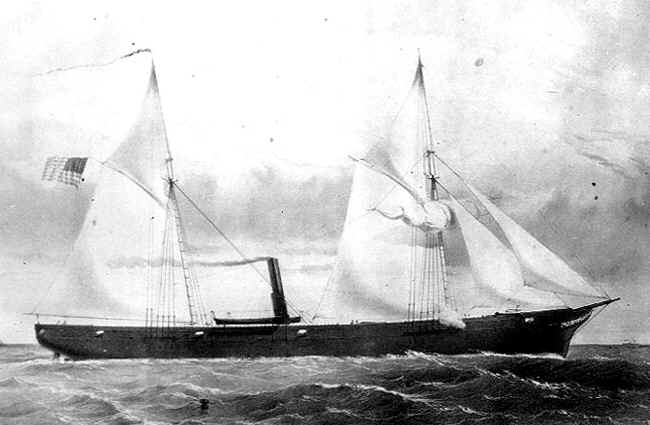
Unadilla-class
gunboat (“90-day” gunboats). USS Ottawa would look like this.
Source: US Navy Historical and Heritage Command.
Construction
of Confederate Batteries at St. Johns Bluff
In the summer of 1862, Confederate Brig. Gen. Joseph Finegan, commander of the Department of Middle and Eastern Florida, began to construct an earthworks and battery of guns on St. Johns Bluff, on the south bank of the St. Johns River about 4 miles upriver from Mayport Mills, with the intent of restricting or halting US Navy operations on the river. Possibly he was acting under orders from Gen. Lee to attempt to secure the St. Johns and Apalachicola Rivers for continued use by the forces of the Confederacy. The work at St. Johns Bluff was completed 9 September 1862. The St. Johns bluff battery consisted initially of 6 guns, and Finegan planned to supplement this with an additional four following the first engagement with the US Navy on 11 September. After its capture, the inventory of guns in the battery was: two 8” smoothbore, two 8” Columbiads, three 8” siege howitzers, and two rifled 4.6” guns, for a total of 9 artillery pieces. Some field guns were also present, but these were taken by the rebels when they withdrew from the fortifications. Finegan had a second battery of guns constructed at Yellow Bluff, on the north bank of the river about 1 mile upriver of St. Johns Bluff. This battery consisted of 8 guns. (6)
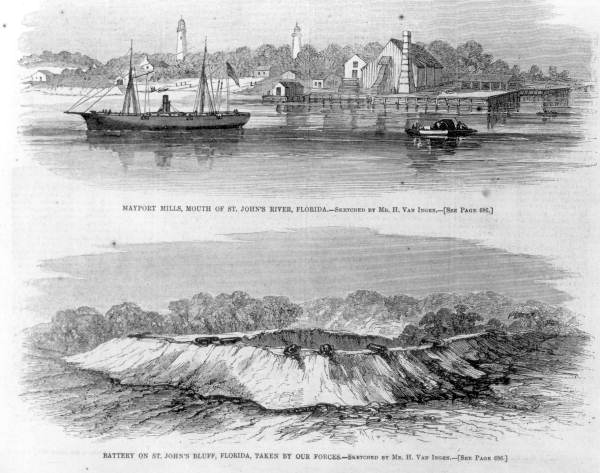 |
Union Navy base at Mayport Mills
Confederate
earthworks at St. Johns Bluff
Source: Florida Dept. of State on-line photo archive |
An
escaped slave named Israel informed Acting Master W. D. Urann, of the US gunboat
Patroon, that the confederates had constructed a battery on St. Johns
Bluff about the same time it was completed. Evidently, the officers of the
St. Johns River squadron had not had good experiences with the information
provided by these “contrabands”, and were consequently skeptical.
Urann relayed the contraband’s report to Acting Master L. G. Crane, of the US
gunboat Uncas, who decided to conduct his own reconnaissance up the river
on 10 September. Proceeding upstream, accompanied by the Patroon,
Crane arrived off St. Johns Bluff at dusk. He had his crew set out a kedge
anchor to enable his ship to bring its broadside to bear and lobbed nine shells
into the bluff, receiving no return fire. Apparently the rebels in the
fortifications in the bluff did not respond in an effort to keep their location
unknown at that time(7).
The morning of 11 September dawned with a different experience. At daybreak, the rebel battery opened fire on the Uncas. Crane ordered the anchor cable slipped and cut loose the kedge anchor rigged the night before. Many of the ship’s guns had been run in for the purpose of swabbing the decks, and it evidently took some extra time to bring them into action. Uncas was hit five times, one shot actually penetrating the magazine, before the gunboat was able to begin maneuvering to avoid the fire from the battery and return fire. Crane signaled for the Patroon to come upriver to lend fire support. Due to the strong tidal currents in this portion of the river, it took an hour and a half for the Patroon to maneuver into position to bring its guns to bear on the bluff. Uncas and Patroon dueled with the battery for over four hours, expending 203 shell and 13 solid shot between the two ships. Crane reported that many of their shells exploded within and around the earthworks, and that they drove the rebels off for a short period of time. (8)
The
Union Navy Response
DuPont
commended Masters Crane and Urann for their actions of 10-11 September, and
began to make plans for a more extensive operation against the St. Johns Bluff
fortification. Until the attack on Uncas and Patroon, DuPont
had made it clear to the people of Jacksonville and the surrounding areas that
the Navy would display no hostilities towards them if his ships were not
“molested.” (9) He sent orders to Cdr. Charles Steedman of the US
gunboat Paul Jones to assemble a squadron consisting of his ship
and the gunboats, Uncas, Cimarron, E. B. Hale, and Patroon.
Steedman’s orders were to “make a thorough reconnaissance of the river as
far as you deem it advisable.” and to ascertain why the Uncas and Patroon
were attacked. (10)
Steedman’s squadron got underway from Mayport Mills the morning of 17 September and headed upriver. At a range of 2,000 yards, Paul Jones and Cimarron opened fire on St. Johns Bluff with their big 100 pdr Parrott rifles. This fire appeared to have not much of an effect on the battery. At a range of 1,600 yards, the rebel battery began to return fire. The gunboats Uncas, Patroon, and Hale misunderstood Steedman’s orders to go into action in line ahead formation, and their fire was “of little, if any, service.” It may be that instead of closing with the battery at a range sufficient to bring their lighter guns to bear, they followed Paul Jones and Cimarron, and consequently were mostly out of range. Steedman estimated that he was under fire from 6 or 8 guns on the battery and in the adjacent woods. Exchange of fire between the gunboats and the battery continued for several hours. Both Paul Jones and Cimarron were hit. As with the engagement on 11 September, the gunboat fire was sufficient to drive the rebels away from the battery. The Navy ships expended about half their ammunition in this engagement. Steedman gave orders to cease firing and retire downriver; he felt that to continue upriver to Jacksonville would allow the rebels to reoccupy the battery and put his ships at peril on the return trip downriver. CS Gen. Finegan reported that 2 of his men were killed and 3 wounded in the naval assault on the battery. Steedman sent the Uncas to Port Royal with his after action report to DuPont, and to obtain fresh ammunition for his ships. The Water Witch was dispatched from Port Royal to Steedman, with orders to obtain fresh ammunition for the 100 pdr Parrott rifles from ships blockading the Georgia coast (as none was available at Port Royal for the Uncas). (11)
 |
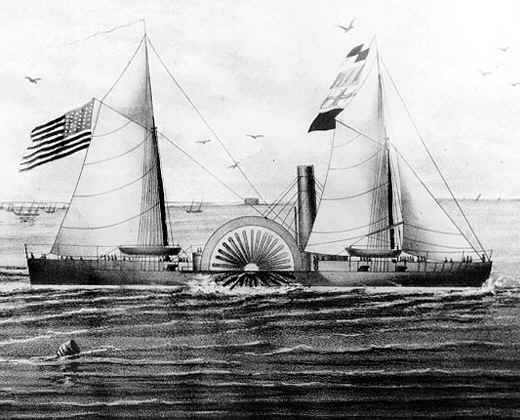 |
|
Gunboats Paul Jones (left) and Cimarron (right). Source: US Naval Historical and Heritage Command web site. |
|
As a result of the naval actions of 11 and 17 September, the Union leadership in the region came to the realization that it would take a combined Army/Navy amphibious operation to conquer the battery on St. Johns Bluff. Planning began in the last weeks of September 1862. US Gen. John M. Brannan was dispatched from Hilton Head, SC with a force of infantry, cavalry and light artillery, 1,500 men in total. DuPont directed Steedman to continue to harass the battery on St. Johns Bluff with “an occasional shot.” Due to heavy weather, the departure of the expeditionary force was delayed until on or after 23 September, when DuPont authorized the expedition to proceed. The expedition departed on 25 September. (12)
The
Amphibious Assault
The
gunboats Paul Jones, Cimarron, Uncas, E. B. Hale and Water Witch rendezvoused
with the transports carrying Brannan’s forces on 1 October 1862. They
proceeded upriver to Pablo Creek and Mt. Pleasant Creek, where they began to
land the Army troops, supported by US Marines armed with Dahlgren 12 pdr boat
howitzers. The force began to make their way towards the battery on St.
Johns Bluff. (13)
On 2 October, concurrent with the developing assault on the St. Johns Bluff fortifications, Steedman ordered Commander Maxwell Woodhull of the gunboat Cimarron, accompanied by the Water Witch and Uncas, to conduct a reconnaissance of the Bluff. The battery commenced firing on the Union ships as they passed the mouth of Sisters Creek, the Union ships returning fire. The firing from the battery was well aimed, and the Cimarron encountered difficulties in maneuvering due to a combination of strong tidal currents, wind, and the poor handling characteristics of the ship, all of which made it difficult for Woodhull to bring his guns to bear on the battery. Amazingly, little damage was inflicted on the ships, even though many shots landed close enough that the deck crews were doused with water. Both Cimarron and Water Witch ran aground for a period of time, during which they continued to receive fire from the battery. The fight continued for about an hour and a half, after which the three ships received a signal from Steedman to return downriver and help cover the troop landing. (14) No casualties were suffered on any of the three Union ships, to Cdr. Woodhull’s astonishment.
The infantry, cavalry, and artillery were all landed by 3 October, and the Union force began to push its way west towards St. Johns Bluff. As they advanced, it was noticed that no flag was flying over the battery. Although this suggested the rebels had abandoned the works, Steedman was skeptical, since no flag had been observed flying the day before, when the battery fired on the Cimarron, Water Witch, and Uncas. In consultation with Gen. Brannan, Steedman dispatched the Hale and Uncas upriver to conduct another reconnaissance of the battery. Arriving off the battery, Acting Master Alfred T. Snell of the Hale ordered his guns to open fire, but received no return fire from the earthworks. He dispatched an armed shore party in the ship’s gig to the battery, where they found that the rebel garrison had evacuated the works as the Union force pushed its way towards the Bluff. Union forces raised the US flag over the fortification on 3 October 1862. (15) The battery upriver at Yellow Bluff was also evacuated by Confederate forces on or about this date.
Afterward:
The River War Continued
The conquest and occupation of the St. Johns Bluff battery opened the river to US Navy forces to conduct expeditions up the St. Johns River. This they did, destroying or taking possession of every small boat, scow, or barge they could find in order to impede the ability of rebel troops and supplies to be ferried across the river. In a 4 October expedition up the river by Cimarron, Water Witch and Hale, Cdr. Woodhull reported that 200-300 small vessels were destroyed. On the way up, the Cimarron continued to display poor handling, at one point steaming upriver stern first. Woodhull transferred his command to the Water Witch and continued the expedition up the river. Arriving off Palatka on 5 October, Woodhull reported that he met aboard Water Witch with former Florida Gov. Moseley and a unionist named Blood. Moseley reported that the rumor had been widely spread that it was the intent of the US forces to arrest and execute or imprison every southern white man found. Woodhull sent Moseley back ashore with assurances that this was not at all the case, and that if the citizens of the region behaved peaceably, they had nothing to fear from the Union. During this meeting, a party of armed horsemen were spotted approaching the town by lookouts in the tops of the gunboats. Woodhull signaled for his boats to return to the ships and ordered Snell in the Hale to open fire on the mounted party. The fire was accurate and deadly, apparently killing 3 or 4 of the horsemen. The fire of the gunboat forced the mounted party to retreat back into the adjoining forests and swamps. Blood and his family and the families of black pilots who had assisted the Navy ships with navigation on the river were evacuated for their safety. Snell took the Hale to reconnoiter in the Orange Mills area (downstream of Palatka), then rejoined the squadron at Jacksonville. (16)
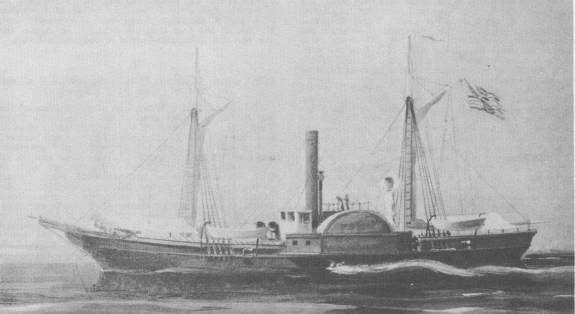
USS
Water Witch
Source: US Navy Historical and Heritage Command web site
A cutting out expedition set out on 6 October to capture the Confederate steamer Gov. Milton, and another steamer. It was known that the Milton was responsible for ferrying rebel troops and guns to the fortifications on St. Johns Bluff, and that it was also important in conveying supplies run through the Blockade to Confederate forces. Under the command of Lt. Cdr. E. P. Williams, the recently captured Confederate steamer Darlington (rechristened a US ship with the same name, and armed with two 24 pdr boat howitzers) steamed upriver, accompanied by the gunboat Hale. At the entrance to Lake George, shallow depths wouldn’t allow Hale to proceed further, so the Darlington continued upriver through Lake George, leaving Hale to patrol the entrance to the Ocklawaha River, nearby. At Hawkinsville, 168 miles upstream of Jacksonville, Williams and his men found indications that the Milton was in the area. Taking a party of sailors and soldiers of the 47th Pennsylvania Volunteer Regiment, Williams proceeded up a small creek in ships boats and found the Milton, manned by only two engineers. They took possession of the steamer and reconnoitered up the creek further in search of the other steamer, then out into the St. Johns River as far up as Lake Beresford. When the steamboats could go no further due to river depths, running low on rations, and deep in rebel-held territory, Williams decided to proceed back downriver to the squadron. Along the way up and back down river, numerous small vessels and other rebel property was destroyed or confiscated by the Union expedition (17).
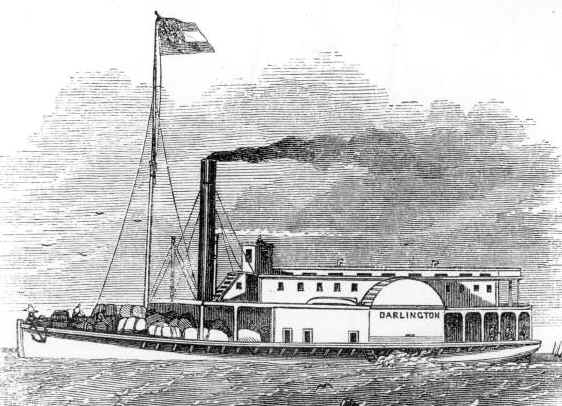
Steamer
Darlington – blockade runner captured at Fernandina and put into
service as US Navy steamboat.
Source: Florida Dept. of State on-line photo archive.
Epilogue
The year 1862 closed with the Union Navy in control of the St. Johns River. Towards the end of the war, Confederate forces in the area had some successes against the Navy, using both emerging new technologies and their local “guts and know-how.” Four US transport ships were sunk by torpedoes (mines) on the river in 1864, and the armed tug Columbine was ambushed and burned/sunk that same year at Horse Landing by elements of the Second Florida Cavalry, CSA, under the command of CS Capt. John J. Dickison. But the commitment and resolve of the Navy officers and sailors serving on the St. Johns River blockade to fulfill their mission were an important part of the overall Navy contribution to the success of the Union in the Civil War in Florida.
|
SOURCES AND NOTES (1) Gary Loderhose, Way Down Upon the Suwannee River. Sketches of Florida During the Civil War (Lincoln, NE: Authors Choice Press, 2000), pp 27-39; Robert A. Taylor, Rebel Storehouse. Florida’s Contribution to the Confederacy (Tuscaloosa, AL: University of Alabama Press, 2003), Chapt. 5. (2) Lewis N. Wynne and Robert A. Taylor, Florida in the Civil War (Charleston, SC: Arcadia Publishing, 2002), pp. 28-29; John J. Koblas, The Swamp Fox and the Columbine (Minnesota: Northstar Press of St. Cloud, 2003), p.76. (3) Robert M. Browning, Jr., Success Is All That Was Expected. The South Atlantic Blockading Squadron during the Civil War (Washington, D.C.: Brassey’s, Inc., 2002), pp. 66-70. (4) Rodgers to DuPont, 12 March 1862, Official Records of the Union and Confederate Navies in the War of the Rebellion (ORN), Series 1, Vol. 12, pp.595-597; also excerpted in Susan F. Chase and Carol S. Clark, Letters from the River War. Civil War on the St. Johns River 1862. (National Park Service: Eastern National Press, 2007), pp.10-11; Daniel Ammen, The Atlantic Coast. Campaigns of the Civil War (New York, NY: The Blue & the Gray Press, 1959), p. 53. (5) Browning, pp. 70-71; Stevens to DuPont, 17 March 1862, ORN Series 1, Vol. 12, pp. 631-632; Ammen ( p. 59) indicates that the Ottawa, Seneca and Pembina crossed the St. Johns River bar on March 10; Budd to Stevens, 13 March 1862, ORN Series 1, Vol. 12, pp. 699-700; Minutes of the Session, First Presbyterian Church of Palatka, March 1862. (6) Finegan to Cooper, 12 September 1862, ORN, Series 1, Vol. 13, p. 326; Steedman to DuPont, 4 October 1862, ORN Series 1, Vol. 13, p. 357; Koblas, p. p. 80; Florida State Park system web site; Yellow Bluff Fort Historic State Park History: http://www.floridastateparks.org/yellowbluff/History.cfm. (7) Crane to DuPont, 11 September 1862, ORN Series 1, Vol. 13, pp. 324-325; Koblas, p. 85. (8) Crane to DuPont, 11 September 1862, ORN Series 1, Vol. 13, pp. 324-325. (9) DuPont to Crane, 15 September 1862, ORN Series 1, Vol. 13, pp. 325-326; Browning, pp. 120-121; DuPont to Steedman, 15 September 1862, ORN Series 1, Vol. 13, pp. 327-328. (10) DuPont to Steedman, 15 September 1862, ORN Series 1, Vol. 13, pp. 327-328; Browning, pp. 121-122. (11) Steedman to DuPont, 17 September 1862, ORN Series 1, Vol. 13, pp. 329-330; Finegan to Cooper, 19 September 1862, ORN Series 1, Vol. 13, p. 331; DuPont to Pendergrast, 22 September 1862, ORN Series 1, Vol. 13, p. 341. (12) Steedman to DuPont, 17 September 1862, ORN Series 1, Vol. 13, pp. 329-330; DuPont to Steedman, 20 September, 1862, ORN Series 1, Vol. 13, pp. 336-37; Browning (p. 121) indicates the force was 4,500 men, but all other accounts, including the reports in the ORN, indicate it was 1,500. I believe Browning’s figure is just a misprint, not an outright error; DuPont to Mitchell, 21 September 1862, ORN Series 1, Vol. 13, p. 339; Ibid, 23 September 1862, ORN Series 1, Vol. 13, pp.342-343; Mitchell to DuPont, 24 September 1862, ORN Series 1, Vol. 13, p. 346. (13) Steedman to DuPont, 3 October 1862, ORN Series 1, Vol. 13, p. 355; Steedman to DuPont, 14 October 1862, ORN Series 1, Vol. 13, pp. 362-365. (14) Woodhull to Steedman, 3 October 1862, ORN Series 1, Vol. 13, p. 356; Steedman to DuPont, 3 October 1862, ORN Series 1, Vol. 13, p. 355; Steedman to DuPont, 14 October 1862, ORN Series 1, Vol. 13, pp. 362-365. (15) Steedman to DuPont, 14 October 1862, ORN Series 1, Vol. 13, pp. 362-365; Abstract from the log of the E. B. Hale, ORN Series 1, Vol. 13, p. 370. (16) Woodhull to Steedman, 7 October 1862, ORN Series 1, Vol. 13, pp. 367-370; Abstract from the log of the E. B. Hale, ORN Series 1, Vol. 13, p. 370; Snell to Steedman, 14 October 1862, Charles Steedman, Letters 1862-1863: Archived in the Florida History Collection of the Geo. A. Smathers Library, University of Florida, Gainesville, FL. (17) Williams to Steedman, 9 October 1862, ORN Series 1, Vol. 13, pp. 366-367; Abstract from the log of the E. B. Hale, ORN Series 1, Vol. 13, p. 370; Ammen, p. 70. |